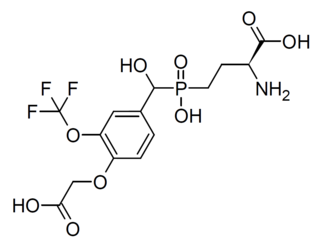Related Research Articles

An epileptic seizure, informally known as a seizure, is a period of symptoms due to abnormally excessive or synchronous neuronal activity in the brain. Outward effects vary from uncontrolled shaking movements involving much of the body with loss of consciousness, to shaking movements involving only part of the body with variable levels of consciousness, to a subtle momentary loss of awareness. Most of the time these episodes last less than two minutes and it takes some time to return to normal. Loss of bladder control may occur.

The α-amino-3-hydroxy-5-methyl-4-isoxazolepropionic acid receptor is an ionotropic transmembrane receptor for glutamate (iGluR) that mediates fast synaptic transmission in the central nervous system (CNS). It has been traditionally classified as a non-NMDA-type receptor, along with the kainate receptor. Its name is derived from its ability to be activated by the artificial glutamate analog AMPA. The receptor was first named the "quisqualate receptor" by Watkins and colleagues after a naturally occurring agonist quisqualate and was only later given the label "AMPA receptor" after the selective agonist developed by Tage Honore and colleagues at the Royal Danish School of Pharmacy in Copenhagen. The GRIA2-encoded AMPA receptor ligand binding core was the first glutamate receptor ion channel domain to be crystallized.

In excitotoxicity, nerve cells suffer damage or death when the levels of otherwise necessary and safe neurotransmitters such as glutamate become pathologically high, resulting in excessive stimulation of receptors. For example, when glutamate receptors such as the NMDA receptor or AMPA receptor encounter excessive levels of the excitatory neurotransmitter, glutamate, significant neuronal damage might ensue. Excess glutamate allows high levels of calcium ions (Ca2+) to enter the cell. Ca2+ influx into cells activates a number of enzymes, including phospholipases, endonucleases, and proteases such as calpain. These enzymes go on to damage cell structures such as components of the cytoskeleton, membrane, and DNA. In evolved, complex adaptive systems such as biological life it must be understood that mechanisms are rarely, if ever, simplistically direct. For example, NMDA in subtoxic amounts induces neuronal survival of otherwise toxic levels of glutamate.

Dizocilpine (INN), also known as MK-801, is a pore blocker of the N-Methyl-D-aspartate (NMDA) receptor, a glutamate receptor, discovered by a team at Merck in 1982. Glutamate is the brain's primary excitatory neurotransmitter. The channel is normally blocked with a magnesium ion and requires depolarization of the neuron to remove the magnesium and allow the glutamate to open the channel, causing an influx of calcium, which then leads to subsequent depolarization. Dizocilpine binds inside the ion channel of the receptor at several of PCP's binding sites thus preventing the flow of ions, including calcium (Ca2+), through the channel. Dizocilpine blocks NMDA receptors in a use- and voltage-dependent manner, since the channel must open for the drug to bind inside it. The drug acts as a potent anti-convulsant and probably has dissociative anesthetic properties, but it is not used clinically for this purpose because of the discovery of brain lesions, called Olney's lesions (see below), in laboratory rats. Dizocilpine is also associated with a number of negative side effects, including cognitive disruption and psychotic-spectrum reactions. It inhibits the induction of long term potentiation and has been found to impair the acquisition of difficult, but not easy, learning tasks in rats and primates. Because of these effects of dizocilpine, the NMDA receptor pore blocker ketamine is used instead as a dissociative anesthetic in human medical procedures. While ketamine may also trigger temporary psychosis in certain individuals, its short half-life and lower potency make it a much safer clinical option. However, dizocilpine is the most frequently used uncompetitive NMDA receptor antagonist in animal models to mimic psychosis for experimental purposes.

Kainate receptors, or kainic acid receptors (KARs), are ionotropic receptors that respond to the neurotransmitter glutamate. They were first identified as a distinct receptor type through their selective activation by the agonist kainate, a drug first isolated from the algae Digenea simplex. They have been traditionally classified as a non-NMDA-type receptor, along with the AMPA receptor. KARs are less understood than AMPA and NMDA receptors, the other ionotropic glutamate receptors. Postsynaptic kainate receptors are involved in excitatory neurotransmission. Presynaptic kainate receptors have been implicated in inhibitory neurotransmission by modulating release of the inhibitory neurotransmitter GABA through a presynaptic mechanism.

Kainic acid, or kainate, is an acid that naturally occurs in some seaweed. Kainic acid is a potent neuroexcitatory amino acid agonist that acts by activating receptors for glutamate, the principal excitatory neurotransmitter in the central nervous system. Glutamate is produced by the cell's metabolic processes and there are four major classifications of glutamate receptors: NMDA receptors, AMPA receptors, kainate receptors, and the metabotropic glutamate receptors. Kainic acid is an agonist for kainate receptors, a type of ionotropic glutamate receptor. Kainate receptors likely control a sodium channel that produces excitatory postsynaptic potentials (EPSPs) when glutamate binds.

Glutamate receptors are synaptic and non synaptic receptors located primarily on the membranes of neuronal and glial cells. Glutamate is abundant in the human body, but particularly in the nervous system and especially prominent in the human brain where it is the body's most prominent neurotransmitter, the brain's main excitatory neurotransmitter, and also the precursor for GABA, the brain's main inhibitory neurotransmitter. Glutamate receptors are responsible for the glutamate-mediated postsynaptic excitation of neural cells, and are important for neural communication, memory formation, learning, and regulation.

In the field of neurology, temporal lobe epilepsy is an enduring brain disorder that causes unprovoked seizures from the temporal lobe. Temporal lobe epilepsy is the most common type of focal onset epilepsy among adults. Seizure symptoms and behavior distinguish seizures arising from the medial temporal lobe from seizures arising from the lateral (neocortical) temporal lobe. Memory and psychiatric comorbidities may occur. Diagnosis relies on electroencephalographic (EEG) and neuroimaging studies. Anticonvulsant medications, epilepsy surgery and dietary treatments may improve seizure control.

Quisqualic acid is an agonist of the AMPA, kainate, and group I metabotropic glutamate receptors. It is one of the most potent AMPA receptor agonists known. It causes excitotoxicity and is used in neuroscience to selectively destroy neurons in the brain or spinal cord. Quisqualic acid occurs naturally in the seeds of Quisqualis species.
Post-traumatic epilepsy (PTE) is a form of acquired epilepsy that results from brain damage caused by physical trauma to the brain. A person with PTE experiences repeated post-traumatic seizures more than a week after the initial injury. PTE is estimated to constitute 5% of all cases of epilepsy and over 20% of cases of acquired epilepsy.

Spike-and-wave is a pattern of the electroencephalogram (EEG) typically observed during epileptic seizures. A spike-and-wave discharge is a regular, symmetrical, generalized EEG pattern seen particularly during absence epilepsy, also known as ‘petit mal’ epilepsy. The basic mechanisms underlying these patterns are complex and involve part of the cerebral cortex, the thalamocortical network, and intrinsic neuronal mechanisms.
A convulsant is a drug which induces convulsions and/or epileptic seizures, the opposite of an anticonvulsant. These drugs generally act as stimulants at low doses, but are not used for this purpose due to the risk of convulsions and consequent excitotoxicity. Most convulsants are antagonists at either the GABAA or glycine receptors, or ionotropic glutamate receptor agonists. Many other drugs may cause convulsions as a side effect at high doses but only drugs whose primary action is to cause convulsions are known as convulsants. Nerve agents such as sarin, which were developed as chemical weapons, produce convulsions as a major part of their toxidrome, but also produce a number of other effects in the body and are usually classified separately. Dieldrin which was developed as an insecticide blocks chloride influx into the neurons causing hyperexcitability of the CNS and convulsions. The Irwin observation test and other studies that record clinical signs are used to test the potential for a drug to induce convulsions. Camphor, and other terpenes given to children with colds can act as convulsants in children who have had febrile seizures.
GABA transporters (Gamma-Aminobutyric acid transporters) belong to the family of neurotransmitters known as sodium symporters, also known as solute carrier 6 (SLC6). These are large family of neurotransmitter which are Na+ concentration dependent. They are found in various regions of the brain in different cell types, such as neurons and astrocytes.

Methylazoxymethanol acetate, MAM, is a neurotoxin which reduces DNA synthesis used in making animal models of neurological diseases including schizophrenia and epilepsy. MAM is found in cycad seeds, and causes zamia staggers. It selectively targets neuroblasts in the central nervous system. In rats, administration of MAM affects structures in the brain which are developing most quickly. It is an acetate of methylazoxymethanol.
James O. McNamara is an American neurologist and neuroscientist, known for his research of epileptogenesis, the process underlying development and progression of epilepsy. He is the Duke School of Medicine Professor of Neuroscience in the Departments of Neurobiology, Neurology, and Pharmacology and Cancer Biology at Duke University. He served as chair of the Department of Neurobiology at Duke from 2002 to 2011
Gene therapy is being studied for some forms of epilepsy. It relies on viral or non-viral vectors to deliver DNA or RNA to target brain areas where seizures arise, in order to prevent the development of epilepsy or to reduce the frequency and/or severity of seizures. Gene therapy has delivered promising results in early stage clinical trials for other neurological disorders such as Parkinson's disease, raising the hope that it will become a treatment for intractable epilepsy.

Alon Friedman is a professor of Neuroscience at both Ben-Gurion University of the Negev (BGU) in Beersheba, Israel, and in Dalhousie University, Halifax, Nova Scotia, Canada. He is best known for his discoveries of the link between blood–brain barrier (BBB) disruption and Epileptogenesis and the mechanisms underlying it, and for the utilization of BBB imaging as a potential Biomarker of epilepsy and other brain diseases.

Willardiine (correctly spelled with two successive i's) or (S)-1-(2-amino-2-carboxyethyl)pyrimidine-2,4-dione is a chemical compound that occurs naturally in the seeds of Mariosousa willardiana and Acacia sensu lato. The seedlings of these plants contain enzymes capable of complex chemical substitutions that result in the formation of free amino acids (See: #Synthesis). Willardiine is frequently studied for its function in higher level plants. Additionally, many derivates of willardiine are researched for their potential in pharmaceutical development. Willardiine was first discovered in 1959 by R. Gmelin, when he isolated several free, non-protein amino acids from Acacia willardiana (another name for Mariosousa willardiana) when he was studying how these families of plants synthesize uracilyalanines. A related compound, Isowillardiine, was concurrently isolated by a different group, and it was discovered that the two compounds had different structural and functional properties. Subsequent research on willardiine has focused on the functional significance of different substitutions at the nitrogen group and the development of analogs of willardiine with different pharmacokinetic properties. In general, Willardiine is the one of the first compounds studied in which slight changes to molecular structure result in compounds with significantly different pharmacokinetic properties.

LSP2-9166 is a drug which acts as a selective agonist for the group III metabotropic glutamate receptors, with a reasonably potent EC50 of 70nM at mGluR4 and 220nM at mGluR7, and weaker activity of 1380nM at mGluR6 and 4800nM at mGluR8. It has anticonvulsant effects in animal studies, and reduces self-administration of various addictive drugs.

Raymond J Dingledine is an American pharmacologist and neurobiologist who has made considerable contributions to the field of epilepsy. He serves as Professor in the School of Medicine at Emory University, Atlanta GA, where he chaired the pharmacology department for 25 years and served as Executive Associate Dean of Research for 10 years.
References
- ↑ Lukasiuk, K. (2014). "Epileptogenesis". In Aminoff, Michael J; Daroff, Robert B (eds.). Encyclopedia of the Neurological Sciences (Second Edition). Vol. 2 (Second ed.). London: Academic Press. pp. 196–199. ISBN 978-0-12-385157-4.
- 1 2 3 4 5 McNamara JO, Huang YZ, Leonard AS (October 2006). "Molecular signaling mechanisms underlying epileptogenesis". Sci. STKE. 2006 (356): re12. doi:10.1126/stke.3562006re12. PMID 17033045. S2CID 42882078.
- 1 2 3 4 5 Armijo JA, Valdizán EM, De Las Cuevas I, Cuadrado A (2002). "Advances in the physiopathology of epileptogenesis: Molecular aspects". Rev Neurol (in Spanish). 34 (5): 409–29. PMID 12040510.
- ↑ Noebels, Jeffrey L.; Avoli, Massimo (2012-06-29). Jasper's Basic Mechanisms of the Epilepsies. Oxford University Press. p. 3. ISBN 9780199746545 . Retrieved 2014-10-16.
- 1 2 3 Herman ST (January 2006). "Clinical trials for prevention of epileptogenesis". Epilepsy Res. 68 (1): 35–8. doi:10.1016/j.eplepsyres.2005.09.015. PMID 16377141. S2CID 46017678.
- 1 2 3 4 5 6 7 8 9 10 Aroniadou-Anderjaska V, Fritsch B, Qashu F, Braga MF (February 2008). "Pathology and pathophysiology of the amygdala in epileptogenesis and epilepsy". Epilepsy Res. 78 (2–3): 102–16. doi:10.1016/j.eplepsyres.2007.11.011. PMC 2272535 . PMID 18226499.
- ↑ "Post-traumatic epilepsy". Br Med J. 2 (6132): 229. 1978. doi:10.1136/bmj.2.6132.229. PMC 1606365 . PMID 98198.
- 1 2 Firlik KS, Spencer DD (2004). "Surgery of post-traumatic epilepsy". In Dodson WE, Avanzini G, Shorvon SD, Fish DR, Perucca E (eds.). The Treatment of Epilepsy. Oxford: Blackwell Science. p. 775. ISBN 0-632-06046-8 . Retrieved 2008-06-09.
- ↑ Schevon CA, Tobochnik S, Eissa T, Merricks E, Gill B, Parrish RR, Bateman LM, McKhann GM Jr, Emerson RG, Trevelyan AJ (2019). "Multiscale recordings reveal the dynamic spatial structure of human seizures". Neurobiol Dis. 127: 303–311. doi:10.1016/j.nbd.2019.03.015. PMC 6588430 . PMID 30898669.
{{cite journal}}: CS1 maint: multiple names: authors list (link) - ↑ Seiffert E, Dreier JP, Ivens S, Bechmann I, Heinemann U, Friedman A (2004). "Lasting blood-brain barrier disruption induces epileptic focus in the rat somatosensory cortex. J". Neuroscience. 24 (36): 7829–36. doi: 10.1523/JNEUROSCI.1751-04.2004 . PMC 6729929 . PMID 15356194.
{{cite journal}}: CS1 maint: multiple names: authors list (link) - ↑ van Vliet EA, da Costa Araujo S, Redeker S, van Schaik R, Aronica E, Gorter JA (2007). "Blood-brain barrier leakage may lead to progression of temporal lobe epilepsy". Brain. 130 (2): 521–534. doi: 10.1093/brain/awl318 . PMID 17124188.
{{cite journal}}: CS1 maint: multiple names: authors list (link) - ↑ Ivens S, Kaufer D, Seiffert E, Bechmann I, Tomkins O, Heinemann U, Friedman A (2007). "TGF-beta receptor mediated albumin uptake into astrocytes is involved in neocortical epileptogenesis". Brain. 130 (Pt 2): 535–47. doi: 10.1093/brain/awl317 . PMID 17121744.
{{cite journal}}: CS1 maint: multiple names: authors list (link) - 1 2 Cacheaux LP, Ivens S, David Y, Lakhter AJ, Bar-Klein G, Shapira M, Heinemann U, Friedman A, Kaufer D (2009). "Transcriptome profiling reveals TGF-beta signaling involvement in epileptogenesis". Journal of Neuroscience. 29 (28): 8927–8935. doi:10.1523/JNEUROSCI.0430-09.2009. PMC 2875073 . PMID 19605630.
{{cite journal}}: CS1 maint: multiple names: authors list (link) - ↑ David Y, Flores LP, Ivens S, Heinemann U, Kaufer D, Friedman A (2009). "Astrocytic dysfunction in epileptogenesis: consequences of altered potassium and glutamate buffering?". Journal of Neuroscience. 29 (34): 10588–99. doi:10.1523/JNEUROSCI.2323-09.2009. PMC 2875068 . PMID 19710312.
{{cite journal}}: CS1 maint: multiple names: authors list (link) - ↑ Levy N, Milikovsky DZ, Baranauskas G, Vinogradov E, David Y, Ketzef M, Abutbul S, Weissberg I, Kamintsky L, Fleidervish I, Friedman A, Monsonego A (2015). "Differential TGF-β Signaling in Glial Subsets Underlies IL-6-Mediated Epileptogenesis in Mice". J Immunol. 195 (4): 1713–22. doi: 10.4049/jimmunol.1401446 . PMID 26136430.
{{cite journal}}: CS1 maint: multiple names: authors list (link) - ↑ Weissberg I, Wood L, Kamintsky L, Vazquez O, Milikovsky DZ, Alexander A, Oppenheim H, Ardizzone C, Becker A, Frigerio F, Vezzani A, Buckwalter MS, Huguenard JR, Friedman A, Kaufer D (2015). "Albumin induces excitatory synaptogenesis through astrocytic TGF-β/ALK5 signaling in a model of acquired epilepsy following blood-brain barrier dysfunction". Neurobiol Dis. 78: 115–25. doi:10.1016/j.nbd.2015.02.029. PMC 4426044 . PMID 25836421.
{{cite journal}}: CS1 maint: multiple names: authors list (link) - ↑ Beghi E (2004). "Aetiology of epilepsy". In Dodson WE, Avanzini G, Shorvon SD, Fish DR, Perucca E (eds.). The Treatment of Epilepsy. Oxford: Blackwell Science. p. 61. ISBN 0-632-06046-8 . Retrieved 2008-06-09.
- ↑ Kaminski, R. M.; Rogawski, M. A.; Klitgaard, H (2014). "The potential of antiseizure drugs and agents that act on novel molecular targets as antiepileptogenic treatments". Neurotherapeutics. 11 (2): 385–400. doi:10.1007/s13311-014-0266-1. PMC 3996125 . PMID 24671870.
- ↑ Friedman A, Bar-Klein G, Serlin Y, Parmet Y, Heinemann U, Kaufer D (2014). "Should losartan be administered following brain injury?". Expert Rev Neurother. 14 (12): 1365–75. doi:10.1586/14737175.2014.972945. PMID 25346269. S2CID 207193826.
{{cite journal}}: CS1 maint: multiple names: authors list (link) - ↑ Bar-Klein G, Lublinsky S, Kamintsky L, Noyman I, Veksler R, Dalipaj H, Senatorov VV Jr, Swissa E, Rosenbach D, Elazary N, Milikovsky DZ, Milk N, Kassirer M, Rosman Y, Serlin Y, Eisenkraft A, Chassidim Y, Parmet Y, Kaufer D, Friedman A (2017). "Imaging blood-brain barrier dysfunction as a biomarker for epileptogenesis". Brain. 140 (6): 1692–1705. doi: 10.1093/brain/awx073 . PMID 28444141.
{{cite journal}}: CS1 maint: multiple names: authors list (link) - ↑ Milikovsky DZ, Weissberg I, Kamintsky L, Lippmann K, Schefenbauer O, Frigerio F, Rizzi M, Sheintuch L, Zelig D, Ofer J, Vezzani A, Friedman A (2017). "Electrocorticographic Dynamics as a Novel Biomarker in Five Models of Epileptogenesis". J Neurosci. 37 (17): 4450–4461. doi:10.1523/JNEUROSCI.2446-16.2017. PMC 6596657 . PMID 28330876.
{{cite journal}}: CS1 maint: multiple names: authors list (link) - 1 2 3 Eadie MJ, Bladin PF (2001). "The interpretation of the epileptic process". A Disease Once Sacred: A History of the Medical Understanding of Epilepsy. London: John Libbey. p. 80. ISBN 0-86196-607-4 . Retrieved 2008-06-12.
- ↑ Leśkiewicz M, Lasoń W (2007). "The neurochemical mechanisms of temporal lobe epilepsy: an update". Prz. Lek. (in Polish). 64 (11): 960–4. PMID 18409413.